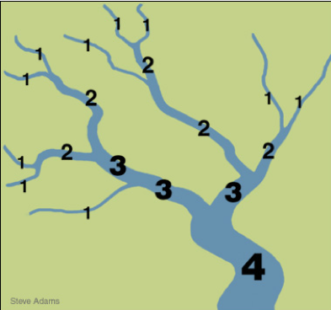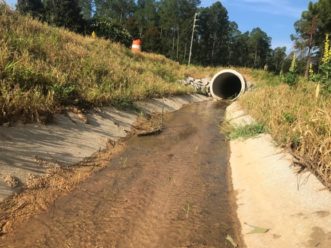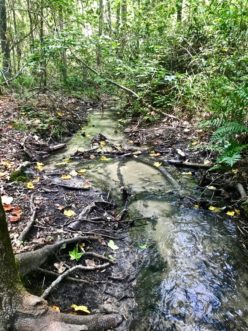The Importance of Streams
Streams serve countless benefits to both society and the environment. They provide recreational opportunities, reduce flooding downstream, and can increase property value. Additionally, across the United States, surface water accounts for up to 70% of our drinking water.1 For aquatic organisms, streams serve as both permanent habitat for stages of development and temporary refuge from disturbances such as flooding and drought. Biota outside of the stream benefit as well, as emerging macroinvertebrates transition from their larval stage in the water to their adult stage on land and serve as a source of energy for riparian organisms.2 These are just a few examples of the ecosystem services streams offer, and headwater streams account for many of them. Unfortunately, streams are increasingly threatened by overdevelopment, loss of floodplain connectivity, and increases in impervious surfaces. These can lead to loss of land and property values, impairments in drinking water, and intensified flooding. Proper practices by landscape professionals; public parks and municipal staff; forestry and land managers and owners; and homeowners association staff can limit stream degradation and preserve aquatic integrity.
What Are Headwater Streams?
Small but often overlooked, headwater streams are of great importance to the ecosystem and the community in a number of ways. In the United States, these systems represent 79% of the overall river network and drain 70% of the land.3 They support drinking water for 1.9 million residents of South Carolina.4 So exactly what is a headwater stream? A headwater stream is considered a “first-order” stream. It is the smallest part of the river or overall stream system and does not have a tributary (figure 1). A wetland outside of the floodplain can be considered a headwater stream, and streams with a variety of permanence also fall into this category. Flow characteristics break streams into three categories: perennial, intermittent, and ephemeral. Perennial streams flow year-round and are found below the water table (figure 2). Intermittent streams flow during the wet season when the water table is above the stream bed but are generally dry during the hotter months when the water table is low. Ephemeral streams only flow after rain events or snow melt. Some ephemeral streams flow so infrequently that there may not be water in the stream bed for up to a year. Drying of stream beds is a natural process and has important implications for both the environment and people.

Figure 1. The Strahler Stream Order5 system allows one to view a stream network by way of tributaries. First-order streams (1), also called headwater streams, can join another first-order stream to become a second-order stream (2) and further merging results in additional stream orders with ascending numbers (3, 4, etc). Image credit: Steve Adams, Minnesota DNR.
Supported Functions
Economic Value
Headwater streams have important economic and ecosystem values. In 2007, Nadeau and Rains estimated the economic value at $15.7 trillion for the conterminous United States and Hawaii.6 Even more, when considering wetlands outside the immediate floodplain, these headwater systems contribute $673 billion a year in the conterminous United States.6 South Carolina has 11,000 miles of streams, of which, 79% or roughly 9,000 miles are headwater systems helping to boost the natural resource economy, including supporting the commercial fishery sector valued at $42 billion.7 The health of downstream waters is essential to the fisheries sector, as headwaters withhold sediment, absorb excess nutrients, and serve as a refuge during drought or thermal stress.
Ecosystem Benefits
One of the most essential benefits of headwater streams is their capacity to mitigate the effects of flooding. In unaltered conditions, headwater streams and wetlands intercept and prevent rain from reaching large rivers. However, when land use changes to impervious cover, the ability of streams to mitigate flooding is compromised. Headwaters not only decrease the volume of floodwater; they also reduce water velocity with their rough and diverse channels. Natural channels help prevent downstream erosion, sedimentation, and flooding unlike artificial concrete channels and pipes which cannot slow water as easily (figure 3). Without large woody debris, coarse substrate, and other natural materials in the stream, water velocity and discharge increase and can cause scouring of sediment, incision of stream banks, and flooding downstream. Additionally, during droughts, when water is in short supply, headwater streams feed larger streams and eventually rivers, maintaining a continuous supply of water.

Figure 3. Streams that have been converted into concrete-lined systems increase the velocity of water and cause downstream flooding. Image credit: Karen Jackson, Clemson Extension.
Headwater systems can physically connect to streams or can influence them through groundwater. This connection is possible via the hyporheic zone. The hyporheic zone is the region of sediment and porous space beneath and alongside a stream bed, where there is mixing of shallow groundwater and surface water. The hyporheic zone separates groundwater from surface water and also serves as important habitat for benthic macroinvertebrates. Benthic macroinvertebrates are small invertebrates that are visible without the use of a microscope and are an integral part of stream systems as they help with stream processing and serve as in-stream and terrestrial food resources. The hyporheic zone is not only a transition zone between groundwater and streams, it can also serve as the transition zone between wetlands and streams. This allows wetlands to serve as important headwater systems. Just as streams and wetlands are important for recharging groundwater, groundwater replenishes streams. The United States Geological Survey estimates that up to half of water in streams and large rivers comes from groundwater, emphasizing the importance of this unseen resource.8
Headwater streams and wetlands also benefit the ecosystem by limiting the amount of sediment reaching larger waterways. Excessive sedimentation can cause numerous water quality issues. Suspended sediment is known to limit plant productivity by reducing photosynthetically available light.9 Sediment entering the system may also carry excess phosphorus into the stream.10 Excess phosphorus in streams can increase the rate of eutrophication of a water body. Eutrophication is a natural process, but when too much of a particular nutrient (phosphorus) is available, it can increase primary productivity, such as algal blooms, which eventually leads to depletion of oxygen.11 This depletion can lead to loss of aquatic life, and excess nitrogen from stormwater runoff can also lead to stream degradation and algal issues.11,12 Studies have shown that headwater systems mitigate this issue through rapid uptake of inorganic nitrogen by algae, bacteria, fungi, and nitrification.13
Threats to Headwater Systems
Headwater systems are threatened by land alteration from urban development, dams, and conversion of streams to artificial channels. Urban development converts naturally permeable surfaces into impervious areas when asphalt, concrete, brick, and stone are used for roadways and within housing developments. The addition of impoundments reduces a waterway’s hydrologic connectivity to the floodplain, which is important for species dispersal. Conversion of the stream bed to an artificial system also results in less habitat for aquatic organisms and faster moving water, ultimately leading to downstream flooding and decreasing recharge of groundwater. Loss of healthy headwater stream systems means a loss of species biodiversity and a decrease in efficient ecosystem processes such as nutrient cycling, organic matter decomposition, and the movement of energy and resources through the food chain.14 Headwaters streams are generally stable systems containing very few predators, making them ideal environments for breeding and rearing. For instance, adult mayflies travel from larger systems to cooler headwaters streams to lay eggs. Because these unique systems are vulnerable to anthropogenic disturbance, species relying on them are declining.15 One of the many threatened or endangered species dependent on headwater systems is the Webster’s Salamander, which has declined due to loss of habitat. This amphibian is found in just five states in six isolated patches.16 The Carolina Heelsplitter also depends on headwaters streams for refuge. Loss of habitat has reduced this mussel from several locations within the Catawba and Pee Dee River systems in North Carolina and the Catawba, Pee Dee, Saluda, and Savannah River systems in South Carolina, to just eight surviving populations.17 These are just two examples of species completely reliant on these smaller, often overlooked systems. The exact percentage of the 130,000 freshwater animal and plant species specific to headwaters is still unknown.
Protecting Headwater Streams
Fortunately, there are many actions those who manage or own properties along headwater streams can take to help preserve them. Maintaining riparian vegetation buffers along streams is a simple practice that does not require training or specialized equipment. Riparian buffers prevent stream erosion and help to mitigate increases in water temperature by providing shade for aquatic life and to remove pesticide and fertilizer contaminants from runoff prior to its entry into streams. Buffer widths may vary depending on site conditions (slope, soil types), contaminant, or issue addressed. For example, 4.6 meters is recommended for short-term control of sediment, 14 meters is recommended for nutrient retention, and 30 meters is recommended for preservation of aquatic habitat.18 North Carolina State University offers additional information and guidance on buffers in their publication, Options for Backyard Stream Repair. The use of pesticides and fertilizers near riparian buffer zones should be limited, and only herbicides that are designated for use in aquatic habitats should be applied. On public properties, educational signage should be placed that explains the benefits of healthy streams and that describe the practices implemented for their protection. Municipal staff such as planning directors and city managers should be encouraged to develop guidelines and regulations that reduce the amount of impervious surface in new developments and preserve floodplain and riparian areas. Additionally, using land in a way that slows water and allows it to infiltrate into the ground can prevent stream degradation. This means less impervious surface and more green spaces such as bioswales, rain gardens, and bioretention cells.
Intact, healthy headwater streams are essential to maintaining water quality. Without these properly functioning systems, flooding will affect homes and property values, drinking water will be compromised, and aquatic organisms will be imperiled. As more habitat and natural space is lost to accommodate our growing population, preserving our headwater streams becomes even more imperative.
References Cited
- Dieter CA, Maupin MA, Caldwell RR, Harris MA, Ivahnenko TI, Lovelace JK, Barber NL, Linsey KS. Estimated use of water in the United States in 2015. Reston (VA): U.S. Geological Survey; 2018 [accessed 2019 Aug 9]; U.S. Geological Survey Circular 1441:65. doi:10.3133/cir1441.
- Baxter CV, Fausch KD, Saunders WC. Tangled webs: reciprocal flows of invertebrate prey link streams and riparian zones. Freshwater Biology. 2005 [accessed 2019 Jul 1];50(2):201-220. doi:10.1111/j.1365-2427.2004.01328.x.
- Colvin SAR, Sullivan SMP, Shirey PD, Colvin RW, Winemiller KO, Hughes RM, Fausch KD, Infante DM, Olden JD, Bestgen KR, Danehy RJ, Eby L. Headwater streams and wetlands are critical for sustaining fish, fisheries, and ecosystem services. Fisheries. 2019;44(2):73–91. doi:10.1002/fsh.10229.
- Analysis of the surface drinking water provided by intermittent, ephemeral, and headwater streams in the U.S. Washington (DC): U.S. Environmental Protection Agency; 2009. [accessed 2019 Jul 25]. https://www.epa.gov/sites/production/files/2015-04/documents/2009_12_28_wetlands_science_surface_drinking_water_surface_drinking_water_results_state.pdf.
- Strahler AN. Quantitative analysis of watershed geomorphology. Eos, Transactions American Geophysical Union. 1957;38(6):913-20. doi:10.1029/TR038i006p00913.
- Nadeau TL, Rains MC. Hydrological connectivity between headwater streams and downstream waters: How science can inform policy. JAWRA Journal of the American Water Resources Association. 2007; 43(1):118–133. doi:10.1111/j.1752-1688.2007.00010.x.
- Willis DB, Straka TJ. The economic contribution of natural resources to South Carolina’s economy. Clemson (SC): Clemson Experiment Station; 2016. FW 13. [accessed 2019 Jun 25]. https://www.clemson.edu/cafls/departments/fec/news/files/fw_13-economic_contributions_of_natural_resources_2.pdf.
- Alley WM, Reilly TE, Franke OL. Sustainability of ground-water resources. Denver (CO): U.S. Geological Survey; 1999. U.S. Geological Survey Circular 1186.
- Berry W, Hill B. The biological effects of suspended and bedded sediment (SABS) in aquatic systems: A review. Narragansett (RI): US EPA; 2003. [accessed 2019 Oct 23]. https://www.waterboards.ca.gov/sanfranciscobay/water_issues/hot_topics/PointBuckler/references/2003_Effects_of_Sediment.pdf.
- Hart MR, Quin BF, Nguyen ML. Phosphorus runoff from agricultural land and direct fertilizer effects: A review. Journal of Environmental Quality. 2004; 33(6):1956-1972. doi:10.2134/jeq2004.1954.
- Dodds WK. Eutrophication and trophic state in rivers and streams. Limnology and Oceanography. 2006; 51:671-680.
- Phosphorus and Water. U.S. Geological Survey. Reston (VA): USGS. [accessed 2019 Oct 6]. https://www.usgs.gov/special-topic/water-science-school/science/phosphorus-and-water?qt-science_center_objects=0#qt-science_center_objects.
- Peterson BJ, Wollheim WM, Mulholland PJ, Webster JR, Meyer JL, Tank J, Marti E, Bowden WB, Valett HM, Hershey AE, McDowell WH, Dodds WK, Hamilton SK, Gregory S, Morrall DD. Control of nitrogen export from watersheds by headwater streams. Science. 2001; 292(5514):86–90. doi:10.1126/science.1056874.
- Wipfli MS, Richardson JS, Naiman RJ. Ecological linkages between headwaters and downstream ecosystems: Transport of organic matter, invertebrates, and wood down headwater channels. JAWRA Journal of the American Water Resources Association. 2007; 43(1):72–85. doi: 10.1111/j.1752-1688.2007.00007.x.
- Richardson JS. Biological diversity in headwater streams. Water. 2019; 11(366):1–19. doi:10.3390/w11020366.
- Hamilton, S. Webster’s salamander. Columbia (SC): (SCWF) South Carolina Wildlife Federation. http://www.scwf.org/websters-salamander.
- Fridell J. Endangered and threatened wildlife and plants; Designation of critical habitat for the carolina heelsplitter; final rule. Asheville (NC): US Fish and Wildlife; 2002. [accessed 2019 Nov 18].
https://web.archive.org/web/20111018025748/http://ecos.fws.gov/docs/federal_register/fr4080.pdf. - Wenger SJ, Fowler L. Protecting stream and river corridors: Creating effective local riparian buffer ordinances. Athens (GA): Carl Vinson Institute of Government. The University of Georgia; 2005. Public Policy Research Series. [accessed 2019 Sep 30]. https://athenaeum.libs.uga.edu/bitstream/handle/10724/19011/57.pdf?sequence=1.
Additional Resources
Caflisch M, Callahan K, Reas Foster C, White AS. Shorescaping freshwater shorelines. 2013; HGIC 1855.
Hartup W. Small-scale solutions to eroding streambanks. NC Cooperative Extension.


